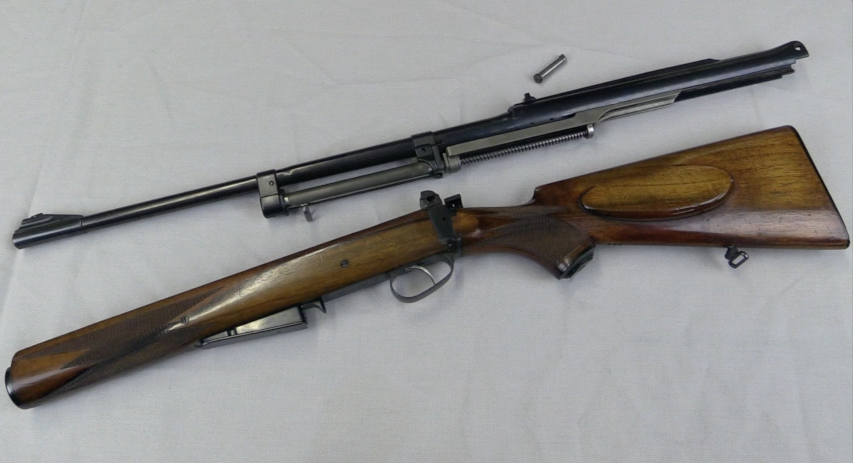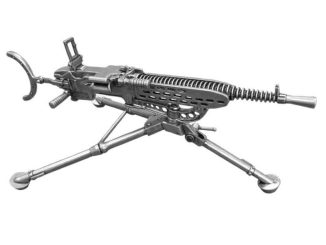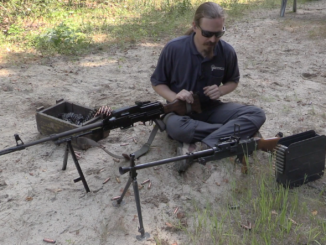While Czechoslovakia was a part of the eastern bloc, it did a pretty thorough job of developing its own weapons rather than use standard Russian designs. For example, the vz52 pistol, vz52, 52/57, and 58 rifles, the uk59 light machine gun, and more. Well, their military sniper rifle was closer to Russian origin, but still not the same.
The vz.54 sniper was made from 1954 until 1957, and served for many years, until replaced by the Dragunov. It was at heart a Mosin-Nagant rifle, but outfitted with a semi-pistol-grip stock, distinctive Czech scope mount, and a few other features. It was chambered for the standard 7.62x54R cartridge, and was capable of excellent accuracy.




Interesting.
the cosmetics of the rifle are more than a little reminiscent of commie period Cz /Brno sporters, the stock design, the tangent site, the straight bolt handle…
the sporter actions have far more in common with a Mauser 98 (that had a one night stand with a pre ’64 Win Mod 70)than a Mosin Nagant, but I wonder whether things like the master pattern for the stock were carried over.
Does anyone have any info on who oversaw the mods? I’m guessing that the Koucky brothers were somewhere in the team.
From what I read (and I do not remember where and if it was available in English) the barreled action was taken completely from supplied Mosin rifles. The original marking was obliterated and replaced with new one. It is conceivable, that some tune-up was done to trigger mechanism. The standard training course shooting was at 800m.
Regarding that you talk about was probably production from the shortly after the war period (1950-58) when they made ZG-49. It was exported to many countries for hard cash.
The vz. 59 was (and still – is) NOT a light machine gun – but a UK vz.59, meaning the Univerzalni Kulomet or GPMG, as it is used on a bipod/tripod/vehicles and fires the full-house Mosin round. The LMG par exellence in the Commie era Czechoslovak Army (the CSLA – Ceskoslovenska Lidova Armada, the Czechoslovak People’s Army) was the LK vz.52 and LK vz. 52/57, a Vaclav Holek (of ZB-26/Bren fame) design of a top fed intermediate round machine gun. The LK vz.52 was a magazine/belt fed weapon, in that sense a Minimi predecessor, and chambered for the Czech intermediate round, the 7.62×45 (the Z50 round). Later on, just like the vz.52 carbine, it was rechambered for the Soviet standard 7.62×39 round and renamed vz.52/57 – and then only fed from the belt, as no LK magazines were ever manufactured for the Soviet round, and no conversion was made to use the Sa vz.58 magazine.
Yeah, I meant GPMG, not LMG (FWIW, there is a company making semiauto copies of the 59 here, and I should be getting one to review).
Now to the vz.54 rifle itself: The development started in 1949, when Otakar Galasch designed the ZG-49 Sn (Zbrojovka, Galasch, 1949, Sniper) sniper rifle chambered for the 7.9×57 Mauser ammo, a follow up of his commercial ZG-47 Mauser-action hunting rifle. Then, with Sovietization of the Czechoslovak state in the wake of February 1948 Communist coup, followed in 1951 two models chambered for 7.62x54R: Mauser-action ZG-51 Sn, and the ZG-51 Sn 91/30, aptly called so because it used the Mosin action. These were design to shoot the machinegun-grade ammo, not special sniper/match rounds, and the military wanted these to group 10 impacts at 800 metres within 500×1000 mm – not pinpoint accuracy by any means. First ZG-51 Sn 91/30 rifles were built on wartime Mosin actions, with newly manufactured bbls, sights (Mauser-styled tangent rear sight), wooden parts and newly made trigger mechanisms.
The military testing begun in the summer 1952, and the results were dismal: even that modest a dispersion target was missed in all four prototypes, despite each having a different bore configuration. The Mauser-actioned prototype was off-limits on ideological grounds, and only served as a comparison weapon. These were also 4 prototypes, with the same bore configurations as the Mosin models – but their dispersion proved even greater. Seems that Mauser bolt did not suited the Mosin ammo at all. Another series of tests was ordered, a year later, in summer of 1953. Two more prototypes with bores modeled after the Soviet sniper variation, and with sniper Mosin actions were tested, and for the first time the dispersion target has been met – and improved upon. These two new prototypes were standardized as the new CSLA sniper rifle Model of 1954 (Odstrelovaci puska vzor 54, the OP-54).
The story was told in a 1971 book Ceskoslovenske rucni palne zbrane a kulomety by Col.Dr. Miroslav Sada, re-edited 2004 with a full color photo insert showing most of the weapons discussed in a book. This was a Czech-only book, with no English version.
I was going to mention that the vz.59 was a full-on GPMG in 7.62mm x 54R caliber, but Leszek beat me to it. Is the book by Col. Dr. Sada still available to the general public?
Based on Leszek’s description in his comments from May 27, 2013 @ 9:06 a.m., it would appear that the original military specifications that spawned the ZG-51 Sn and ZG-51 Sn 91/30 were orientated towards the concept of a sharpshooter’s ( “battlefield sniper”, for want of a better term ) rifle rather than a true sniper rifle that had pin-point accuracy at extreme ranges. The improved accuracy that exceeded these specifications in the later test prototypes that eventually became the vz.54 seem to have been of sufficient magnitude to warrant standardization and adoption as the new “sniper” rifle.
From memory, the late Peter Kekkenon had an interestingf tale from Finland, between the wars.
I’ll see if I can find it over the next few days.
IIRC (open to some doubt) There was a mis match between the bullet and bore dimensions of the Russian Mosin Nagants, and they had never been great performers in the accuracy department.
Finnish work had found that a different bullet design worked very nicely, but a soviet agent had begun an affair with the housemaid of the person in charge of the project and had managed to get to poison the man…
Another awesome post Ian. Great rifle. I love mine.
I found a page with article by someone who shot this rifle recently in CR and made couple of remarks:
http://www.strelci.com/modules.php?name=News&file=article&sid=474
There are some nice detailed pictures.
One of things he says is that the optics is the weak point of the gun and he calls it “miracle” if it (the scope) still works as is supposed to. This might explain why Ian had difficulty to match his aim point with actual pattern.
There are also targets indicating performance of the particular gun he had shot at 100m. As the maximum distance it was used for (according to some sources)is 800m, more practical one (according to this article) and for sporting purposes lately has been 300m. Couple of adds show sale price of vintage rifles in equivalent of approx.$1,000(25,000 CZK). This seems rather high and I’d be very surprised if someone in US would be willing to pay that much even for well shooting unit.
I would expect prices on the vz.54 here in the US to exceed $2000. They are pretty rare, and people who buy them do so for the historical and collector value rather than the actual shooting quality.
Does anyone on here know anything about a 49 model, numbered P 02? Has ZBROJOVKO BRNO NARODNI PODNIK on the left side of the receiver. Also has what appears to be a 3/8″ high rampant lion stamp above and to the left of the 49 with an * to the right of the 49, all these appearing on the left side of the receiver on the chamber end of the action. Stock looks like the VZ33. Bolt with safety on right rear like a ZG 47. Supposedly a sniper model for Israel. Chamber fits 7.62 x 51 but a cast of chamber is longer. Grooves and lands around .306 at muzzle.
Hi folks, nice page and discussions going on here. I’m the person who loan the Vz54 the CR. I have a nice rifle and it is a lot of fun. I’m looking for some accessories (originals are better) if anyone knows where to get them. On the other side remember that Czech sniper rifles or Soviet sniper rifles were disigned diferent than the American ones so the scopes were made to shoot fast to probably a group of persons moving and not for a very long distance single target who stood still. Thanks for sharing it was great to find this page
Hi Ian, thanks for the video!
I have had the pleasure to shoot the rifle in competitions at the end of the 90’s in the Czech Republic, up to 300m. What more, I was also lucky enough to get my hands on a rifle that had been laying around in some dark shelf and had never been shot before. So I had brand new rifle accuracy on a 45-year old piece. I felt that the rifle vastly outmatched my shooting qualities, although at that time, I was a pretty proficient shot.
The ammo predominantly used was the Czech ”heavy” bullet with yellow tip, weighing 11,8 grams.
One moment in the competition involved shooting 10 rounds at the international pistol target 50/20 at 300 meters. The competitors with vz.54 could achieve scores of 85-90 points, good shots on a lucky day even better than that. That amounts to a total accuracy of the whole system (shooter+scope+rifle+ammo) of 1.7 MOA or better, if my maths serves me well.
I would stick out my chin and claim that the rifle on its own could perform sub 1MOA. The competitors also typically considered the vz.54 to be superior to the SVD/Dragunov.
The trigger had to have a pull of at least 15N according to the competition rules. That could explain why you felt it was a it on the heavy side (?).
I guess the weak point ofthe gun was the optics. 2.5 magnification could do a good job at 300m, but I would be curious to see what you would hit at longer ranges.
In the early 90s, some of the vz. 54 actions were re-stocked, fitted with a bipod and with SVD optics mounted instead of the original Meopta. This would then be called the vz.54/90. With the arrival of modern Western rifles, mostly Sig Sauer SSG3000 and Steyr SSG, the vz.54 started disappearing from the firing line.
The accuracy of todays vz. 54 would obviously depend on the history. Most would have totally worn out barrels, I would guess, and the optics would also have taken a beating.
You definitely took me down the memory lane, thanks man!!
bonjour a tous, est il possible de trouver un VZ 54 sans les marquages tcheques